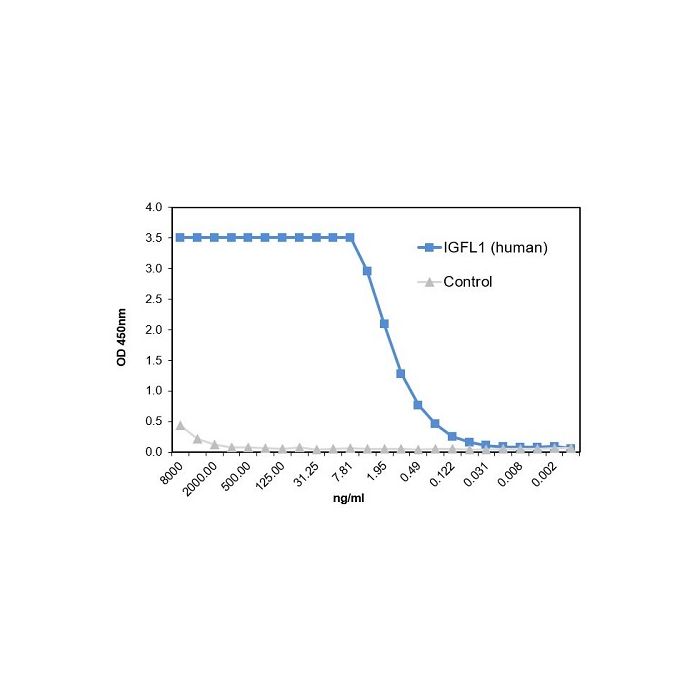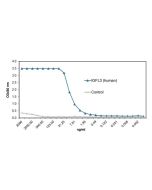Cookie Policy: This site uses cookies to improve your experience. You can find out more about our use of cookies in our Privacy Policy. By continuing to browse this site you agree to our use of cookies.
AdipoGen Life Sciences
IGFLR1 (human):Fc (human) (rec.)

Method: IGFLR1 (human): Fc (human) was coated on an ELISA plate at 1μg/ml overnight at room temperature. IGFL1 (human) (rec.) or negative control was added (starting at 8μg/ml with a twofold serial dilution) for one hour and then detected using an anti-FLAG® antibody (HRP).
Method: IGFLR1 (human): Fc was coated on an ELISA plate at 1μg/ml overnight at room temperature. IGFL3 (human) (rec.) or negative control was added (starting at 8μg/ml with a twofold serial dilution) for one hour and then detected using an anti-FLAG® antibody (HRP).
| Product Details | |
|---|---|
| Synonyms | IGF-like Family Receptor 1; Transmembrane Protein 149; TMEM149; U2 Small Nuclear RNA Auxiliary Factor 1-like 4 |
| Product Type | Protein |
| Properties | |
| Source/Host | HEK 293 cells |
| Sequence |
Human IGFLR1 (aa 23-154) is fused at the C-terminus to the Fc portion of human IgG1. |
| Crossreactivity | Human |
| Specificity |
Binds to its ligand IGFL1 (human) (Prod. No. AG-40B-0244) or IGFL3 (human) (Prod. No. AG-40B-0090) in the subnanomolar range (< 1ng/ml). Does not bind to IGFL4 (Prod. No. AG-40B-0251). |
| MW | ~50kDa (SDS-PAGE) |
| Purity | ≥95% (SDS-PAGE) |
| Endotoxin Content | <0.05EU/μg purified protein (LAL test; Lonza). |
| Concentration | 1mg/ml after reconstitution. |
| Reconstitution | Reconstitute with 50μl sterile water. |
| Formulation | Lyophilized. Contains PBS. |
| Protein Negative Control | |
| Other Product Data |
UniProt link Q9H665: IGFLR1 (human) |
| Shipping and Handling | |
| Shipping | BLUE ICE |
| Short Term Storage | +4°C |
| Long Term Storage | -20°C |
| Handling Advice |
After reconstitution, prepare aliquots and store at -20°C. Avoid freeze/thaw cycles. Centrifuge lyophilized vial before opening and reconstitution. PBS containing at least 0.1% BSA should be used for further dilutions. |
| Use/Stability |
Stable for at least 6 months after receipt when stored at -20°C. Working aliquots are stable for up to 3 months when stored at -20°C. |
| Documents | |
| MSDS |
 Download PDF Download PDF |
| Product Specification Sheet | |
| Datasheet |
 Download PDF Download PDF |
Insulin-growth factor-like gene family is a new family of proteins consisting of four proteins in humans (IGFL1 to 4) and one in mice (mIGFL). mIGFL is expressed in normal skin in mice and further upregulated during inflammation responses in skin or after skin wounding. In human only IGFL1 expression is increased in psoriatic skin samples. mIGFL and human IGFL1 and 3 interact with specificity and high affinity to a novel receptor named IGF-like family receptor 1 (formerly TMEM-149). Analysis of the amino acid sequence of IGFLR1 indicated that this receptor is likely a novel member of the TNF-R family. IGFLR1 is expressed most abundantly on mouse T cells, suggesting that mIGFL and IGFL1 produced in the skin may potentially exert regulatory functions on T cell responses.







